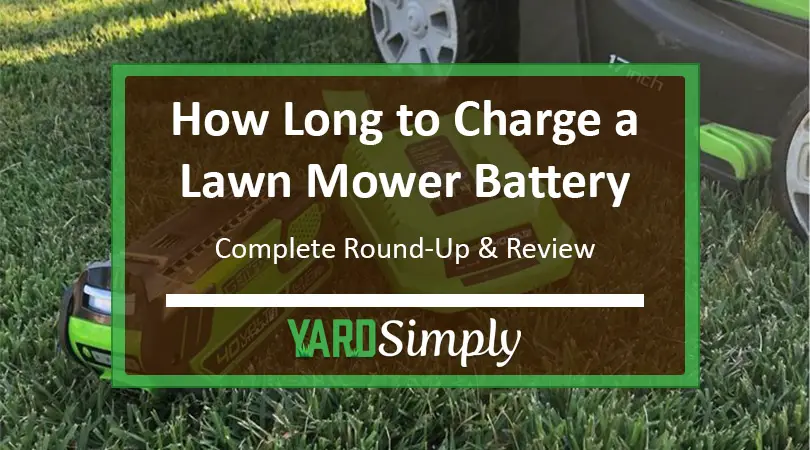Charging your lawn mower battery correctly is key to keeping it running smoothly. With years of hands-on experience and a deep understanding of garden machinery, I’ll give you the straightforward facts you need.
No jargon, just clear instructions that’ll help you get the job done right and your mower ready to go whenever you are.
Key Takeaways
- With a standard charger, it typically takes 8-12 hours, while a fast charger can reduce this time to 4-6 hours, and a super-fast charger can further expedite the process to 1-2 hours.
- Properly charge the lawn mower battery by ensuring it’s off, connecting the charger securely, and monitoring to prevent overcharging for extended battery health.
- Opt for a compatible charger with automatic shut-off and appropriate amperage to safeguard the battery and enhance charging efficiency.
- Choose between lead-acid or lithium-ion batteries, and maintain good charging practices and proper storage to prolong battery life.
Charging Rates Per Type of Charge
The time it takes to charge your lawn mower battery fully can vary significantly depending on the type of charger used. While your mower’s battery capacity and its state of charge play crucial roles, the charger’s speed is a pivotal factor.
Here’s a breakdown of typical charging durations you might expect with different chargers:
- Standard Charger: 8-12 hours to charge a dead battery to full capacity.
- Fast Charger: 4-6 hours to charge a dead battery to full capacity.
- Super-Fast Charger: 1-2 hours to charge a dead battery to full capacity.
Step-by-Step Guide to Charging Your Lawn Mower Battery
The process of charging your lawn mower battery is straightforward, involving a few easy steps. Following this guide, step by step, guarantees proper and efficient charging of your battery, thereby extending its life and maintaining peak performance.
Preparing for Charging
Before charging your lawn mower’s battery, make sure the riding mower is turned off and the battery is accessible. If necessary, consult your mower’s user manual for instructions on locating and accessing the lawn mower battery.
Proper access to the battery ensures a secure connection with the charger, allowing for a more efficient and safe charging process.
Connecting the Charger
To connect your charger to the lawn mower battery, follow these steps:
- Attach the red positive cable to the red positive battery terminal.
- Connect the black negative charging cable to the black battery terminal.
- Make sure the connections are secure and tight to guarantee an efficient flow of electricity during the charging process.
It is important to double-check that the charger’s voltage setting matches the battery’s voltage before connecting the charger to a power source.
Monitoring the Charging Process
Monitoring the charging process is essential to prevent overcharging and ensure optimal battery performance. Keep an eye on the charger’s indicator lights or use a voltmeter to check the battery’s voltage periodically.
When the battery is fully charged, unplug the charger from the battery and the power source. By monitoring the charging process and ensuring the battery does not overcharge.
Safety Precautions
You should always take safety into consideration.
- Wear thick, rubber gloves designed for mechanical work to protect against electrical shocks and acid burns.
- Remove jewelry and secure loose clothing to prevent entanglement or conductivity.
- Charge the battery in a well-ventilated area to avoid the accumulation of hazardous gases.
- Keep a fire extinguisher accessible for emergencies involving electrical fires.
- Inspect the battery for damage such as cracks, leaks, or bulges before charging.
- Confirm that the charger’s voltage is compatible with the battery to prevent overcharging.
- Follow the manufacturer’s guidelines for charging and maintaining the battery.
Factors Affecting Charging Time
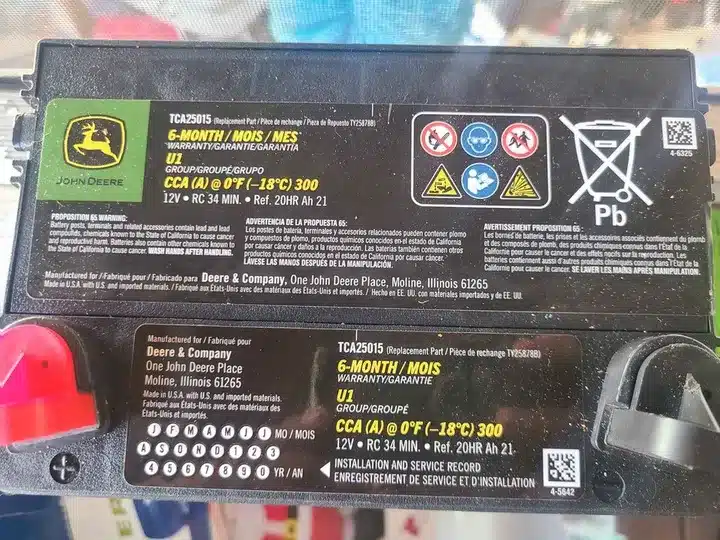
A lawn mower battery’s charging time is influenced by several factors, including battery capacity, charger amperage, and battery age and condition.
Understanding these factors can help you make informed decisions about your battery maintenance routine and ultimately extend the life of your lawn mower battery.
Battery Capacity
Battery capacity, quantified in amp-hours, significantly impacts the charging time for most batteries, lawn mower batteries included. A higher battery capacity necessitates a longer charging time, conversely, a lower capacity leads to a shorter charging time.
The typical capacity of a lawn mower battery in amp-hours ranges from 5 to 12 ampere-hours (Ah).
Familiarity with your lawn mower battery’s capacity enables you to select an appropriate charger and predict the necessary charging duration.
Charger Amperage
Charger amperage refers to the current delivered to a device while it is charging. Higher amperage chargers are known to charge batteries faster, whereas lower amperage chargers are considered to be safer for lawn mower batteries.
Using a high amperage charger on a lawn mower battery can result in faster charging; however, charging a battery too quickly can cause damage to the battery, reduce its performance capacity, shorten its lifespan, and even lead to a fire.
Battery Age and Condition
The age and condition of a lawn mower battery can impact its charging time. Older or damaged batteries will require a longer charging period. As batteries age, their capacity decreases, resulting in longer charging times.
For optimal performance, regular maintenance and timely replacement of batteries is paramount.
Choosing the Right Lawn Mower Battery Charger
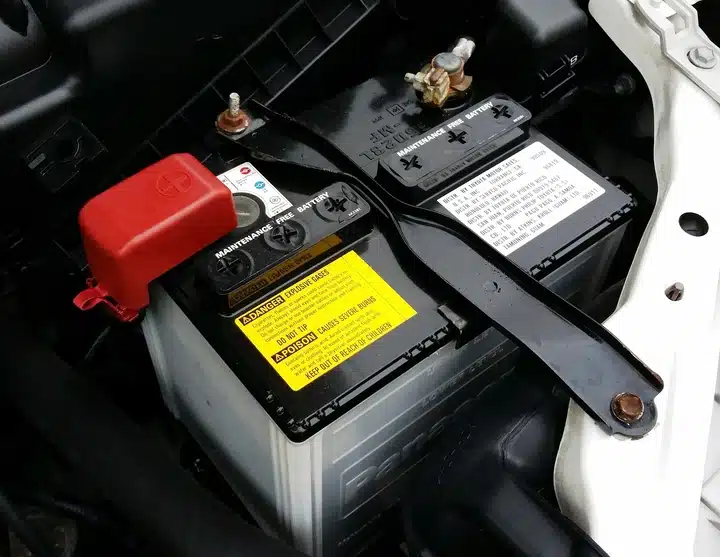
Selecting the ideal battery charger is crucial for maintaining your mower’s battery and prolonging its life. To choose the right charger, consider factors such as voltage compatibility, available amperage options, and additional charger features.
By selecting a charger that meets these criteria, you can ensure your battery charges efficiently and safely.
Voltage Compatibility
A mower battery charger must match the voltage requirement of the lawn mower battery. Generally, lawn mowers use a 12-volt battery, so a 12-volt charger is usually required.
It is imperative to ensure that the charger’s voltage setting is equal to the battery’s voltage.
Lawn mower batteries are typically available in 12 volt or 6-volt options. Using a charger with an incompatible voltage for a lawn mower battery can lead to overcharging, overheating, or even damage to the battery.
Amperage Options
The recommended amperage for charging lawn mower batteries is generally between 2 to 10 amps.
Higher amperage chargers can provide a greater current to the device being charged, thus supplying more power in a reduced timeframe, leading to faster charging.
However, awareness of the potential risks linked to high amperage chargers is crucial, including:
- Elevated release of acidic vapors and hydrogen gas from the battery
- Heightened risk of battery corrosion
- Potential battery overcharging, which could diminish its performance capacity and lifespan.
Additional Charger Features
Modern lawn mower battery chargers may include additional features such as:
- Automatic shut-off: This feature prevents overcharging by monitoring the battery’s voltage and adjusting the charging current accordingly. Upon reaching the battery’s full capacity, the charger will automatically discontinue power supply to avoid overcharging. This feature aids in extending the battery’s lifespan and ensures secure charging.
- Multiple charging modes: Some chargers offer different charging modes, such as fast charging or trickle charging, to accommodate different battery types and charging needs.
- Jump-start capabilities: Certain chargers have the ability to jump-start a dead battery, providing a convenient solution in case of emergencies.
These additional features enhance the functionality and convenience of modern lawn mower battery chargers.
Multiple charging modes are available, which bring the battery up to a full charge and then supply just enough current to maintain it, avoiding any risk of overcharging.
Jump-start capabilities enable you to jump-start the lawn mower battery in the event that it is dead or drained, providing a convenient solution for battery emergencies.
Understanding Lawn Mower Battery Types
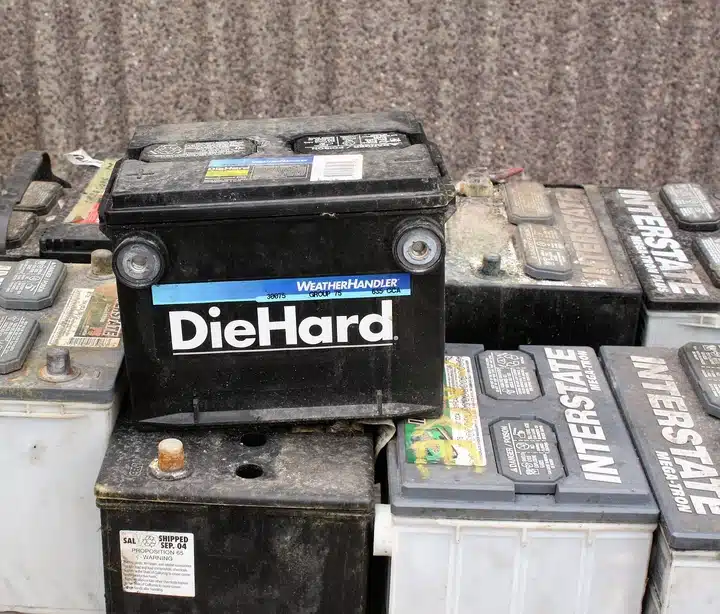
Lawn mowers typically utilize one of two types of batteries: lead-acid batteries or lithium-ion batteries.
Each type of battery has its own set of advantages and disadvantages, making it essential to understand their characteristics to choose the best option for your lawn mower.
Lead-Acid Batteries
Lead-acid batteries, are common in lawn mowers due to their cost-effectiveness and high recycling value. However, they have some downsides, such as their heavy weight and limited power storage capacity.
These batteries require regular maintenance, such as checking water levels in flooded batteries and ensuring the battery terminals are clean and free of corrosion.
Lithium-Ion Batteries
Lithium-ion batteries are becoming increasingly popular in lawn mowers due to their:
- Longer life
- Quicker charging time
- Lightweight design
- Higher energy density
However, they come with a higher price tag and may require special chargers and care.
Lithium-ion batteries are less prone to self-discharge and can maintain their charge for longer periods, making them a convenient option for lawn mower owners who want a low-maintenance lawnmower battery.
When choosing a lithium battery, be sure to select a compatible charger and follow the manufacturer’s guidelines for proper care and maintenance.
Tips for Extending Lawn Mower Battery Life
Proper care and maintenance can significantly extend the life of your lawn mower battery, ensuring that your mower remains in optimal working condition.
We will share tips on how to extend the life of your lawn mower battery in this section, encompassing appropriate storage, regular maintenance, and the cultivation of good charging habits.
Proper Storage
To prolong the life of your lawn mower battery, it is essential to store it in a cool, dry place and avoid exposing it to extreme temperatures. Excessive heat or cold can cause the battery’s capacity to decrease and shorten its lifespan.
If you live in an area with harsh winter conditions, you may want to remove the battery from the mower and store it indoors during the winter months to protect it from the cold.
Regular Maintenance
Performing regular maintenance on your lawn mower battery is crucial to extend its life and maintain optimal performance.
- Checking the battery’s connections
- Checking water levels in flooded batteries
- Cleaning the battery terminals regularly to prevent corrosion, which can inhibit the flow of electricity and shorten the battery’s life.
Charging Habits
Developing good charging habits can also help prolong the life of your lawn mower battery. This includes not overcharging the battery and using the appropriate charger for your battery type.
Overcharging can cause damage to the battery, reduce its performance capacity, and shorten its lifespan.
By using a charger with an automatic shut-off feature and monitoring the charging process, you can prevent overcharging and maintain the health of your lawn mower battery.
Troubleshooting Common Lawn Mower Battery Issues
Inevitably, you may encounter some common issues with your lawn mower battery. This section tackles three frequent lawn mower battery issues: a dead battery, overcharging, and subpar performance.
By understanding how to troubleshoot these issues, you can quickly resolve them and keep your lawn mower running smoothly.
Dead Battery
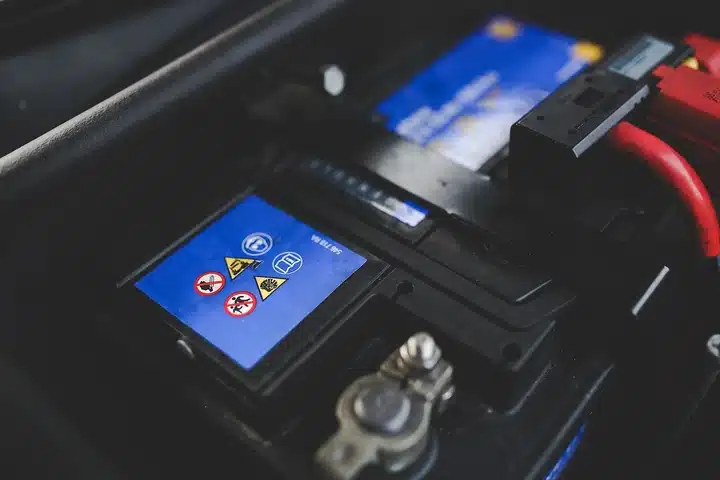
If you find that your lawn mower battery is dead, you can try charging it or jumpstarting it with a compatible charger or vehicle. Ensure that you use the correct charger for your battery type and follow the manufacturer’s guidelines for charging.
If your mower battery is still not holding a charge after attempting to charge or jumpstart it, it may be time to replace it with a new battery.
Related Articles:
- Husqvarna Zero Turn Wont Start
- How To Start A Bad Boy Mower: Reliable Ignition
- Bad Boy Mower Starts Then Dies: Troubleshooting
Overcharging
To prevent overcharging your lawn mower battery, follow these steps:
- Use a charger with an automatic shut-off feature.
- Monitor the charging process.
- The automatic shut-off feature will stop the charging process once the battery is fully charged, preventing damage to the battery.
By keeping a close eye on the charging process and ensuring the battery does not overcharge, you can extend the life of your lawn mower battery and maintain its performance.
Poor Performance
If you notice that your lawn mower battery is not performing as well as it should, check the connections and maintain the battery as needed.
Clean the battery terminals, check the water levels in flooded batteries, and ensure that the battery is fully charged before use.
If the battery continues to perform poorly after addressing these issues, it may be time to replace the battery.
Summary
Understanding the factors affecting lawn mower battery charging time, the types of batteries available, and the tips for extending battery life can significantly improve your lawn care experience.
By choosing the right charger, maintaining your battery, and troubleshooting common issues, you can prolong the life of your preferred lawn mower battery and keep your lawn looking its best.
Remember, a well-maintained lawn mower battery is crucial for ensuring the optimal performance of your lawn care equipment.
Frequently Asked Questions
How long does it take to charge a battery for a lawn mower?
It typically takes around 1 hour to charge a battery for a lawn mower, depending on the charger amperage. However, charging can take up to 3 hours, as the first stage of charging is necessary to recharge the battery to about 75% capacity.
Can you overcharge a lawn mower battery?
Yes, it is possible to overcharge a lawn mower battery if you are not using a newer style smart charger which monitors the state of charge and tapers it off accordingly.
Does a Zero Turn lawn mower charge the battery while it’s running?
Yes, your mower has a charging system that recharges the battery when the engine is running. This will keep the battery charged as long as the engine runs every few weeks. However, if the mower is in storage, the battery will not recharge.
How do you revive a dead lawn mower battery?
Reviving a dead lawn mower battery involves connecting it to a 12-volt battery charger and allowing it to power up for up to eight hours.
What is the typical lifespan of a lawn mower battery?
The typical lifespan of a lawn mower battery is typically between 3 to 5 years, depending on the type and maintenance.

